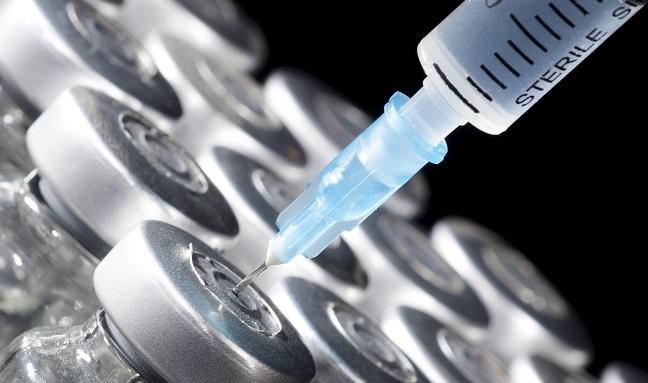Botox Injections Around the Heart Have Lasting Impact on Suppressing A-fib After CABG
In a “fascinating” finding, the benefits endured beyond the botulinum toxin effects. A larger trial is planned to validate this 60-patient pilot study.

BOSTON, MA—Injecting botulinum toxin (Botox) into the epicardial fat pads of patients undergoing CABG appears to be a promising approach for preventing postoperative atrial tachyarrhythmias, extended follow-up of a first-in-human, pilot study shows.
Through 3 years, patients who received Botox injections had a significantly lower rate of any atrial tachyarrhythmia, including A-fib and atrial tachycardia, occurring after 30 days post-CABG in the absence of antiarrhythmic drug treatment (23% vs 50%; HR 0.36; 95% CI 0.14-0.88). Alexander Romanov, MD, PhD (E. Meshalkin National Medical Research Center, Novosibirsk, Russia), reported the results at the Heart Rhythm Society 2018 Scientific Sessions here.
The approach also reduced A-fib burden measured on implantable cardiac monitors and hospitalizations for arrhythmia recurrences, with trends toward less use of antiarrhythmic drugs or A-fib ablation and improved clinical outcomes.
“Botulinum toxin can be viewed as a neuromodulator, and thus differs from the neurodestructive effects of other therapeutic efforts,” Romanov explained during his presentation. “Because the favorable reduction of atrial fibrillation outlasted the anticipated botulinum toxin effect on autonomic nervous system activity, this may represent a form of autonomic reverse remodeling.”
He cited several limitations of the study, including the relatively small sample size, the lack of objective measures to confirm denervation with the injections, the inability to confirm whether functional atrial remodeling occurred, and the lack of information on A-fib burden before surgery.
Thus, the results will need to be validated in larger trials, Romanov said, noting that a multicenter trial sponsored by Allergan—which will examine two different doses of Botox in patients undergoing CABG or valve surgery—is expected to start later this year.
Long-lasting Effect
Postoperative atrial arrhythmias are common after CABG, affecting between 11% and 40% of patients. Previous studies have linked postoperative A-fib and reduced 10-year survival.
This pilot program, Romanov said, was started several years ago based on evidence that neuromodulation of the autonomic nervous system using Botox could decrease the number of A-fib episodes.
The study included 60 patients undergoing CABG who had a preoperative history of paroxysmal A-fib. They were randomized to receive injections of botulinum toxin type A at a dose of 50 U/mL or normal saline (placebo) in each of the four major epicardial fat pads during surgery. All patients received implantable cardiac monitors.
We don’t know why it works, but it really is a fascinating new approach which is worthy of further studies. Kalyanam Shivkumar
Previous results from the study showed that the Botox injections significantly suppressed A-fib at 30 days and 1 year. Romanov said the long-lasting effect was surprising because it exceeded the length of time Botox would be expected to work. The investigators extended follow-up out to 3 years to see if the effects persisted.
The rate of atrial tachyarrhythmias remained lower in the Botox group, with reductions also seen in hospitalizations for arrhythmia recurrences, both in terms of rate (7.0% vs 33.0%; P = 0.02) and total number (3 vs 21; P < 0.001). The proportion of patients on antiarrhythmic drugs also was lower in the Botox group (20.0% vs 50.0%; P = 0.029). There were two deaths and two strokes, all in the placebo group.
Promising, but Not Conclusive
Serving as a discussant following Romanov’s presentation, Kalyanam Shivkumar, MD, PhD (University of California, Los Angeles), pointed out that the mechanisms of A-fib continue to be poorly understood. But prior studies, he said, have targeted the ganglionic plexuses (GPs) in the heart with ablation or other approaches to try to help patients.
“What we’ve seen [in Romanov’s presentation] is a very fascinating study where instead of destroying GPs, we are modulating GPs,” Shivkumar said. “We don’t know why it works, but it really is a fascinating new approach which is worthy of further studies.”
He said the best explanation for why the effects of the approach were sustained for several years is the one provided by Romanov, “that it actually resets the entire nervous system so that it remodels. Are there other specific pathways that we could target? And that’s what their study opens up.”
At a press conference, moderator Andrew Krahn, MD (University of British Columbia, Vancouver, Canada), also indicated that the results are promising, but said questions remain.
“I think the reason why this isn’t conclusive but [is] extremely exciting is because the biologic measures of how this works beyond its time frame . . . are not fully understood,” Krahn said, adding that “there’s a whole bunch of things that need to be sort of measured and understood on a large scale to ensure we realize why it appears to be making such a profound difference.”
Todd Neale is the Associate News Editor for TCTMD and a Senior Medical Journalist. He got his start in journalism at …
Read Full BioSources
Romanov A. Three-year outcomes after botulinum toxin injections into epicardial fat pads for atrial fibrillation prevention in patients undergoing coronary artery bypass grafting. Presented at: HRS 2018. May 11, 2018. Boston, MA.
Disclosures
- Romanov reports relationships with Medtronic, Boston Scientific, Biosense Webster, Spectrum Dynamics, and EP Dynamics.
- Shivkumar reports no relevant conflicts of interest.


Sally Turner